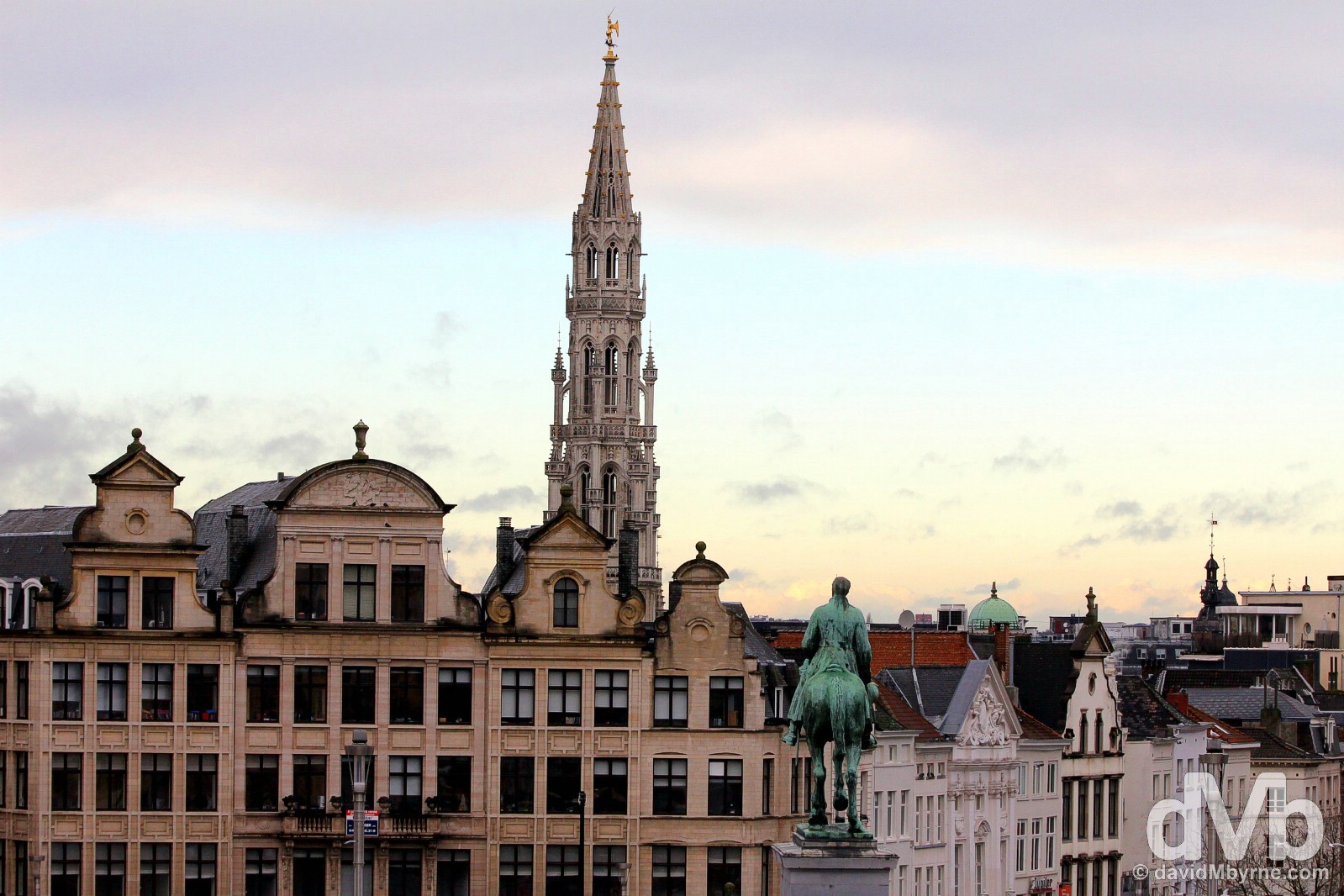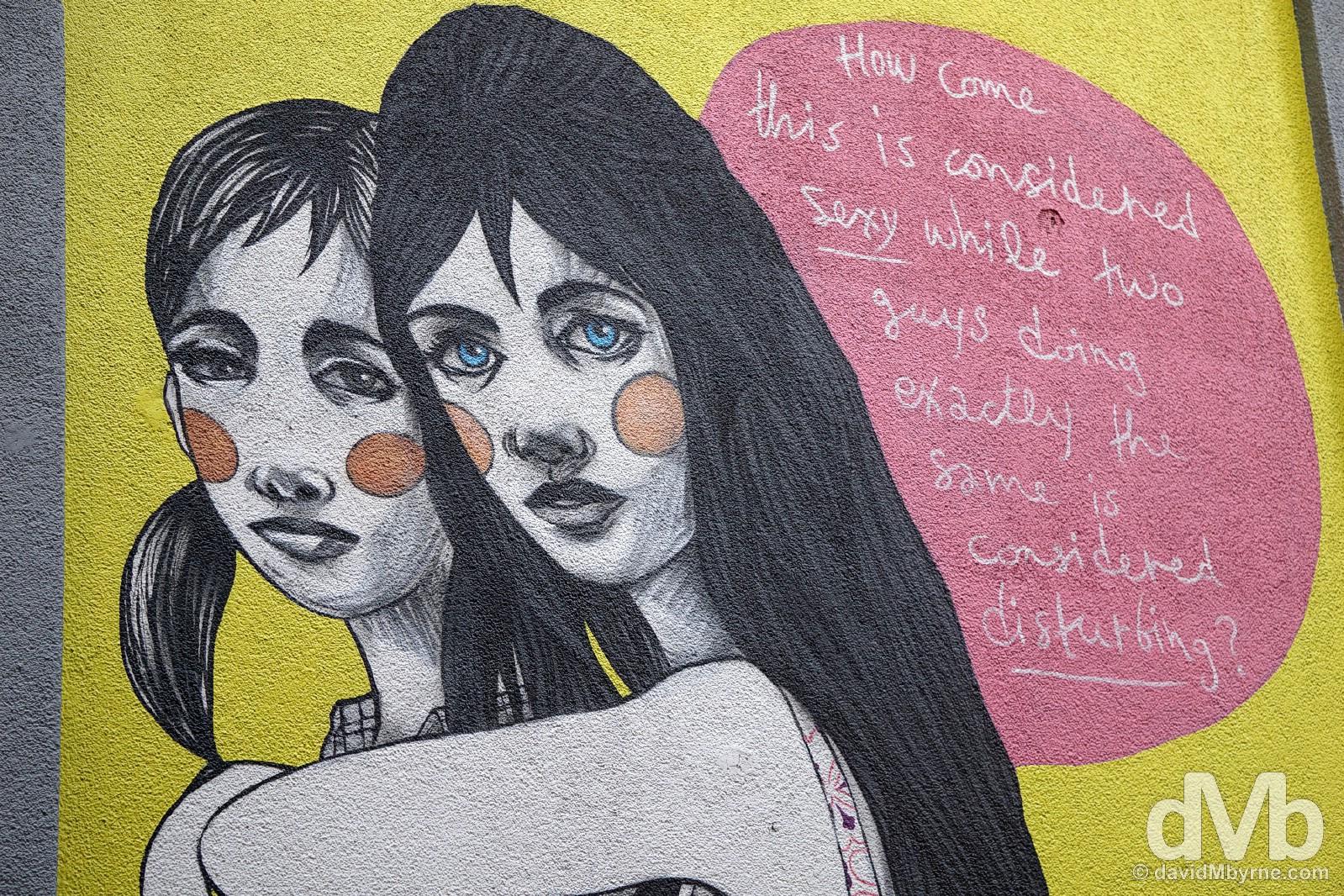Belgium
An Exploration of Belgium’s Big Four – Brussels, Ghent, Bruges & Antwerp“There are beautiful, delicately carved baroque guildhalls in many Belgian towns – I guess it’s all part of the boring-busting charm…”
Image || Markt, Bruges, western Flanders, Belgium. January 16, 2016.
Belgium
Belgium doesn’t get a very good rap. It’s known for its medieval old towns, chocolate, waffles, beer, Tintin, Flemish Renaissance architecture, tolerance, and as the international headquarters of the European Union and NATO. Quite the package for such a small country, one squeezed in between France, Germany and the Netherlands & one divided into 2 distinctive multilingual regions: Dutch-speaking Flanders to the north and French-speaking Wallonia to the south. But it still has a reputation as being dull. Boring even. It can’t be that bad. Roughguides claims it to be perhaps the world’s most ‘misunderstood’ nation. VisitBelgium.com claims it to be the ‘hip European experience you’ve been looking for’ (but they would say that, wouldn’t they?), citing its ‘timeless Gothic & Art Nouveau architecture & majestic castles of the green countryside.’ So there. How’s that boring?
Archived Belgium Entries Posted From The Road (In Chronological Order)
Date || January 13, 2016
Location || Brussels, Belgium ( )
)

The Belgian national dish of mussels & fries in Chez Leon, Lower Town, Brussels, Belgium. January 13, 2016 || I’m not a foodie but seemingly Brussels is a mighty fine place to eat out. So I did just that tonight on my first night in the city, sampling Belgium’s national dish of mussels & fries in the process (washed down, of course, with one of Belgium’s 2000+ varieties of beer). Yes, I had mussels in Brussels & I did so in Chez Leon. In business since 1893 on Rue des Bouchers, Brussels’ most famous dining street just off Grand Place, it’s a favourite with tourists but somehow still manages to remain somewhat authentic at the same time.

Grand Place, the cobbled historic centre of medieval Lower Town in Brussels, Belgium. January 13, 2016 || There are beautiful, delicately carved baroque guildhalls in many Belgian towns – I guess it’s all part of the boring-busting charm – but none quite reaches the heights of those in Brussels’ UNESCO World Heritage listed main square, Grand Place, one of Europe’s finest urban squares. First laid out in the 12th century, Grand Place was to grow to reflect the booming city which was a centre of European cloth trade in medieval times. Back then the square was the hub of commercial, political & civic life in the city & most of the lavish buildings overlooking the cobbled square were built by wealthy merchant guilds as headquarters for their enterprises – guildhalls. Largely destroyed by bombing in 1695, the buildings standing today are 17th century replacements of the original constructions. I’ve only yet seen this place in darkness but I’ll be taking another lengthy look around tomorrow.
– UNESCO commenting on La Grand-Place, Brussels
I’ve been to Brussels before. Indeed, I’ve even worked here in the past, albeit only for a few days and so long ago (it was in 1999) that I scarcely remember anything about the city. I had a look around tonight but I’ll get a proper look tomorrow at the parts of the city I’ve earmarked for exploration; I haven’t time to see it all. Belgium may be one of the smallest countries in Europe but its misunderstood capital is a bit of a spread-out beast. And not a boring one either.
UPDATE || I did get a proper look around. See more destination photography & insights from Brussels as posted in the entry Brussels – The Underappreciated Belgian Capital.
Date || January 15, 2016
Location || Bruges, Belgium ( )
)
I left Ghent earlier today, arriving in Bruges. That was some 24 hours after leaving Brussels to arrive in Ghent, all three locations a quick, smooth & economical 30-minute train ride apart. The Belgian cities are changing fast but the weather isn’t; it has been non-stop miserable since I arrived in the country a few days ago. I’d read that climatically Belgium this time of year is a tad depressing but gosh, the conditions of the last few days make me yearn for the Irish January sun. Yes, I did just type that. Apart from being constantly wet, I’m loving the medieval architectural overload that Belgian Flanders has treated me to thus far. Medieval Belgium probably reaches its zenith here in Bruges, somewhere, unlike Brussels & Ghent before it, that is getting two nights of dMb’s time – after all, Bruges is the reason I’m in Belgium. More to come from In Bruges (sorry, I couldn’t help it) in due course but for now here’s a trio of pictures captured today while dodging heavy hail showers in Ghent.

Sint Niklaaskerk/St. Nicholas’ Church, left, & the UNESCO-listed Belfry in Ghent, centre, as seen from the St Michielsburh bridge over the Leie River in Ghent, western Flanders, Belgium. January 15, 2016 || A frame filling shot of two of what I’m calling the Ghent Three, a trio of medieval towers that form the famed skyline of central medieval Ghent – the missing mainstay, the tower of the city’s St. Baaf’s Cathedral, intentionally hidden behind the row of medieval buildings to the right, is presently covered in an ugly coat of scaffolding and is way too much of an eyesore right now to make an appearance here (standards). The tower of Sint Niklaaskerk/St. Nicholas’ Church was the first of the Ghent Three to be erected but it has played second fiddle to the 91-metre-tall Belfry of Ghent, Belgium’s tallest, since its erection way back in 1313 (although only the lower half was erected then – the tower as we see it today wasn’t completed until the early 1900’s). Added to the UNESCO World Heritage list in 1999, today the Ghent Belfry is the city’s main draw, something that’s all too obvious when you’re requested to part with a rather steep €8 to scale its narrow confines.
UNESCO commenting on the Belfries of Belgium and France

Sint Niklaaskerk/St. Nicholas’ Church as seen from the windswept 91-metre-tall, UNESCO-listed Belfry in Ghent, western Flanders, Belgium. January 15, 2016 || After paying €8 to scale the Ghent Belfry, this is the best I could come up with given the howling, freezing winds, driving rain and tight confines, a picture looking back towards the early 13th century Sint Niklaaskerk/St. Nicholas’ Church. It’s free to go in there, and it’s warm too.

Crossing the Leie River in Ghent, western Flanders, Belgium. January 15, 2016 || The building on the left is the Great Butchers Hall, a late-medieval meat market built between 1407 and 1409. It survives to this day as a somewhat pitiful promotion and tasting hall for regional produce. That said, the warm inside sharply contrasts the cold stone exterior.
Date || January 16, 2016
Location || Bruges, Belgium ( )
)
Bruges is one of Europe’s most beguiling cities. Yes, it is a tad fake & more than a bit touristy but the so-called Venice of the North will keep even the most hardened of travellers content for a day at least. It did me.

Afternoon hail showers in Market, central Bruges, western Flanders, Belgium. January 15, 2016 || Blue skies today yes but not yesterday after arriving in the city from Ghent. I was caught in a heavy hail shower shortly after first laying eyes on Markt, Bruges’ nerve centre & the larger of the city’s two car-free cobbled squares. Flanked by medieval-style buildings and lorded over by the famous Bruges belfry, the Belfort, Markt has been the heart of Bruges since medieval times.
Bruges is made for wandering and wander is what I did today. And for the most part it was a glorious day for it – the clouds came to spoil the party every now and then. It meant there was plenty of water around, and not just in the city’s canals.

A horse-drawn carriage in Burg, Bruges, western Flanders. Belgium. January 16, 2016 || Burg is Bruges’ other cobbled square, a smaller space that is arguably more picturesque than the neighbouring Markt. It’s also enclosed, although only on 3 sides, by very impressive buildings. In the distance is the city’s main attraction, its 83-metre high Belfort, Belgium’s most famous bell tower. It has dominated the city skyline for over 700 years, since its construction in the thirteenth century. By the way, there are no trams in Bruges. There are few cars even. It’s largely a pedestrian city with the option for hopping into a horse-drawn carriage (how romantic).

St Salvatorskathedraal and western Bruges during a late afternoon hail shower as seen from the city’s Belfort. Bruges, western Flanders, Belgium. January 16, 2016 || It’ll cost you €10 & a bit of exertion as you climb the 366 steps of the spiral staircase inside the tight confines of the Belfort to access its viewing deck. Once you get there the views over the rooftops of the city are great. When I was up there the city was in the midst of yet another hail shower.
Just like Ghent, Bruges grew wealthy on the back of cloth trading. It has had its up & downs over the years but today it’s firmly on the up, riding as it is the tourism wave; it does have an industry on the outskirts of the city but the bulk of its earnings these days come from extracting money from the likes of me.

A picturesque procession on Mariastr, Bruges, western Flanders, Belgium. January 16, 2016 || I’m really not too sure what was happening here, a mid Saturday afternoon procession down one of the city’s main roads. It sure was photogenic.

Buildings and the statue of Jan Breidel & Pieter de Coninck, two Bruges craftsmen who led a revolt against the ruling French in 1301-1302, in Markt, Bruges, western Flanders, Belgium. January 16, 2016 || Back to Markt when the sun was out. Bruges may have been suspended in time centuries ago but most of the present-day delights on show are the result of many restorations over the years, including the majority of the buildings enclosing Markt. Not that that’s likely to bother too many. It certainly didn’t bother UNESCO who enlisted the centre of Bruges on its world Heritage list in 2000.
UNESCO commenting on the Historic Centre of Brugge
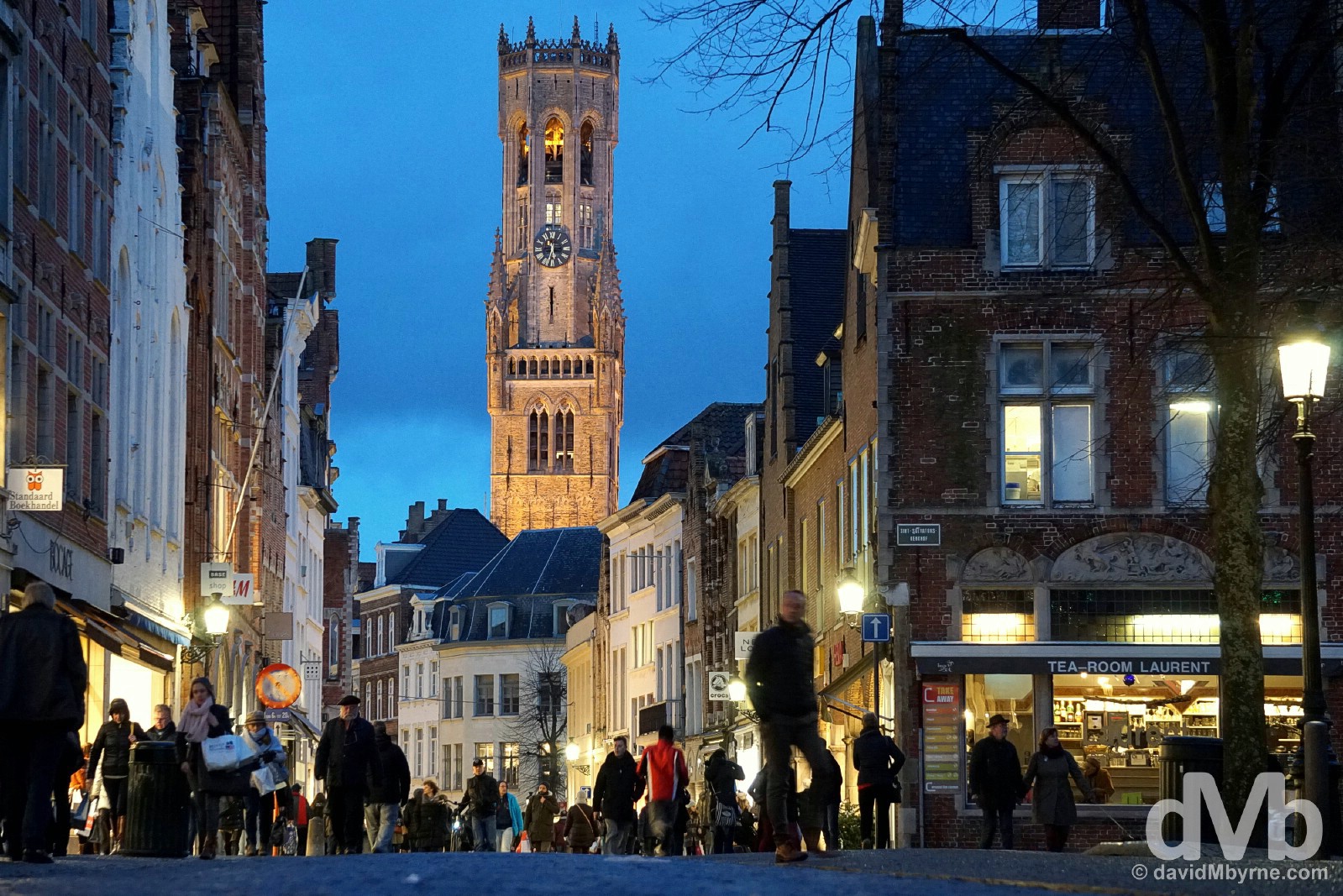
The Belfort at dusk as seen from as seen from Steenstr, the main shopping street in Bruges, western Flanders, Belgium. January 16, 2016 || A final shot of the Belfort as the light dies this evening. A symbol of the city’s power and autonomy for centuries, the Belfort, which had a spire that burnt down in 1741 and was never reconstructed, was built in three phases between the thirteenth & fifteenth centuries. Used also as a watchtower, the main purpose of the belfry during medieval times was as a sort of public service beacon – bells were used to signal the time of day as a way of organising the chaotic daily life in the city.
I’m in Bruges for a few more hours. When I wake in the morning I’ll be off to Netherlands via Antwerp. Where in Netherlands I’ve no idea. I’ll know when I get there.
Date || January 17, 2016
Location || Delft, Netherlands ( )
)
I’ve said it before and I’ll say it again – I love rail travel in Europe. Frequent, fast, comfortable and affordable. Today, and after a final Sunday morning & early afternoon parting scoot around the historic centre of Bruges, I boarded a train to Antwerp, stashed my bags in its impressive train station, paid a fleeting visit to the historic centre of the city, and was shortly thereafter on a train to my present location of Delft, via Rotterdam, in Holland. Three cities & trains, two countries, one day & no hassle. Just like that. I love travelling when I’m travelling; I love getting places as well as the places themselves. So today was my kind of day.

A section of the impressive interior of Centraal Station, Antwerp, Belgium. January 17, 2016 || One of the city’s premier landmarks, it was built between 1895 and 1905 to a harmonious blend of styles, a nice way of saying that the eclecticism of the architectural influences of its constructions doesn’t fit any one particular architectural style. Widely regarded as the finest example of railway architecture in Belgium, 2014 saw it being awarded Most Beautiful Train Station in The World status by British-American magazine Mashable while in 2009 American Newsweek magazine judged it to be the world’s fourth greatest train station. The multilevel beast is big, bright & airy with a huge central dome over the marble-heavy entrance hall, seen here, and glass-covered platforms on the upper levels (see later picture).
Antwerp
Belgium’s second city and the most populous city in Flanders, Antwerp is a fashion hub & the country’s capital of cool. The city, Europe’s second largest port, is famous as the world’s leading diamond centre – 70% of all the world’s diamonds are traded here. It has a long and culturally rich history, including being one of the world’s most important financial centres in the 16th century where traders from all over Europe and Asia sold and bought their goods. While its medieval centre, beautiful in its own right, may not be as historically preserved as say Bruges or Ghent, modern-day trendy, dynamic, cosmopolitan & confident Antwerp still manages to impress with not only the country’s most impressive train station but also its most impressive cathedral.
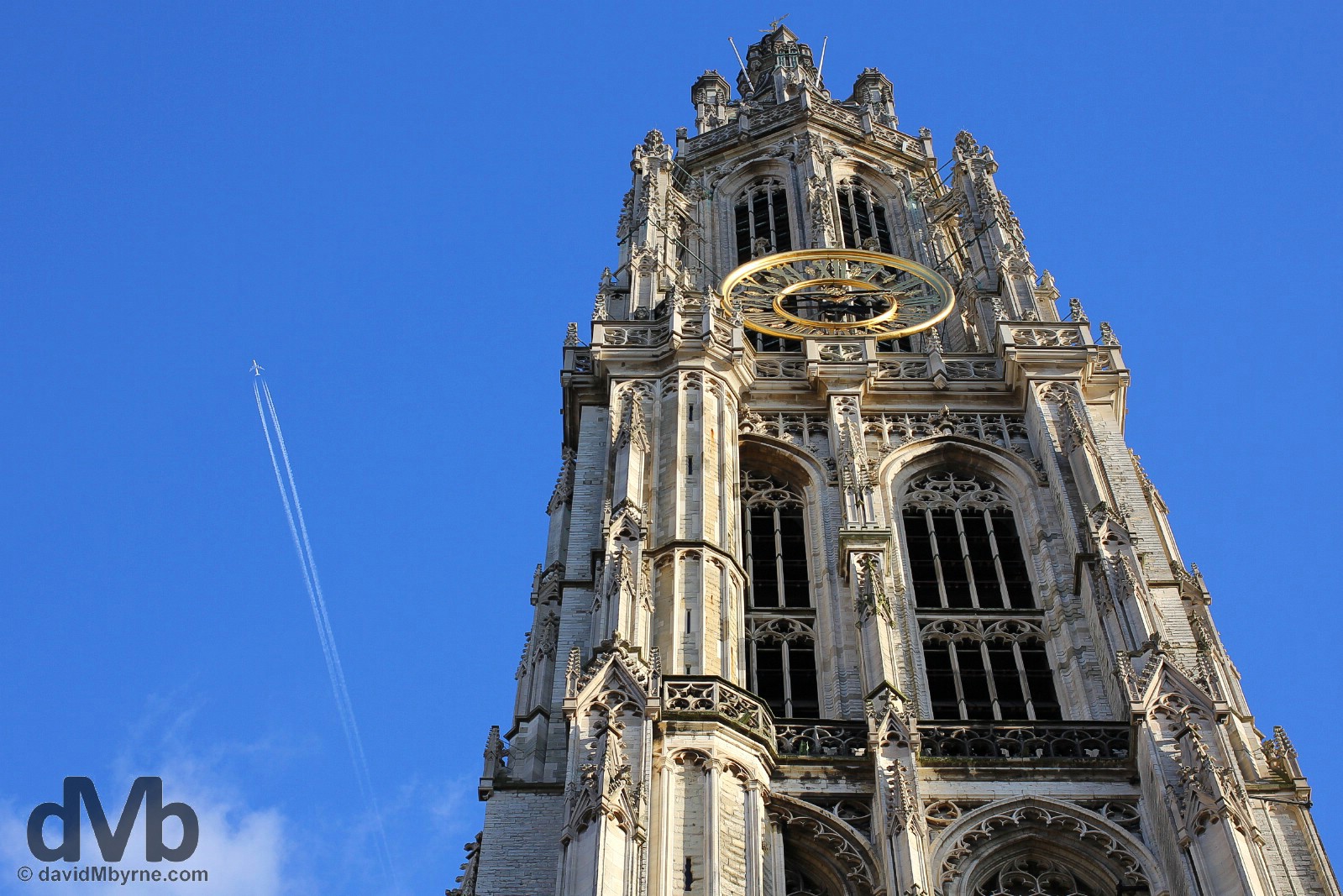
Blue sky, high flyers & the spire of the Onze Lieve Vrouwekathedraal (Cathedral of Our Lady), Antwerp, Belgium. January 17, 2016 || The 123 metre-high spire, the highest church tower in the Benelux, of Antwerp’s Roman Catholic Onze Lieve Vrouwekathedraal (Cathedral of Our Lady) is part of the UNESCO-listed Belfries of Belgium and France. It’s the defining feature of the one of the largest Gothic cathedrals in northern Europe, construction on which commenced in 1351. It took almost 170 years to build but even that wasn’t enough time to see the completion of a proposed matching spire – by 1521 the south spire only reached the height of the third string course and has never been completed. Not only is the cathedral Belgium’s most impressive Gothic structure but it’s also something of an art gallery housing as it does a few masterpieces by Pieter Paul Rubens (1577-1640), one of northern Europe’s greatest baroque artists. As such there an entry fee to access the cathedral’s imposing interior making it feel like a tourist attraction first & an actual house of worship second. Antwerp, Belgium. January 17, 2016.
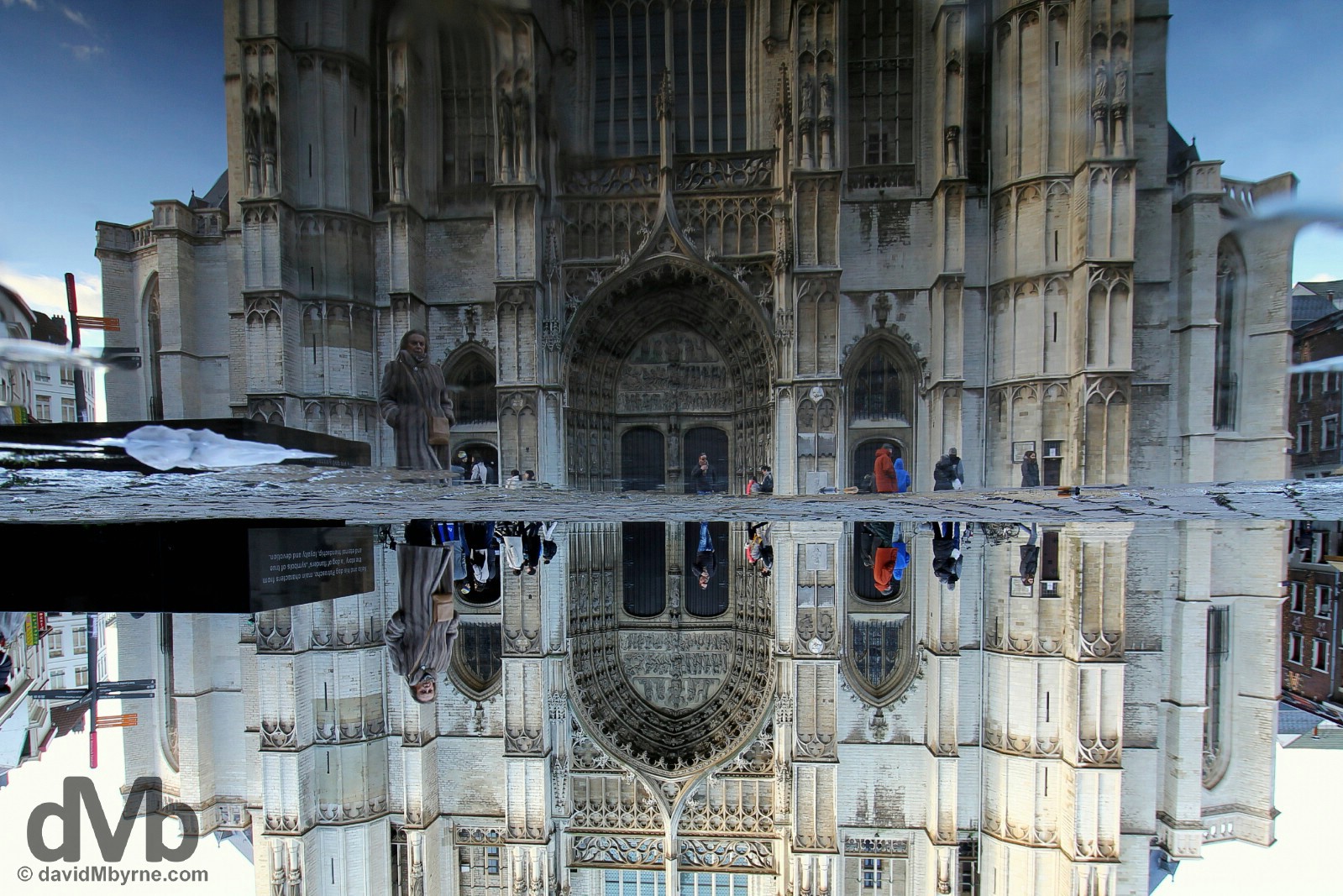
Reflections in a pool in Handschoen Markt, a small cobble pedestrian square fronting the Onze Lieve Vrouwekathedraal (Cathedral of Our Lady) in central Antwerp, Belgium. January 17, 2016.

Detail above the main entrance to the Onze Lieve Vrouwekathedraal (Cathedral of Our Lady) in Antwerp, Belgium. January 17, 2016.

Sunday afternoon in Groenplaats in central Antwerp, Belgium. January 17, 20166.

Grote Markt, Antwerp, Belgium. January 17, 2016 || Just as in Brussels, Ghent & Bruges before it, life in Antwerp revolves around its opulent, pedestrianised central market square, Grote Markt. Surrounded by the old reliables of beautifully restored Renaissance-style guildhalls as found in most historical Flemish towns, Antwerp’s Grote Markt is compact and just a tad photogenic. The guildhalls found here were all reconstructed in the 19th century. Especially photogenic when illuminated by the setting sun as seen here, the most impressive of the lot is No 7. Also the tallest, it’s topped by a gold statue of St George astride a rearing horse as he spears a dragon. Seen here, and taking pride of place in the middle of the Grote Markt, is the Barbo Fountain, a symbol of the city. With a pile of rocks as a base, the statue, dating to 1887, depicts the legend of Antwerp’s name. The legend that says Silvius Barbo, a Roman warrior, chopped off the hand of a giant and threw it in the river, Hand werpen (hand throwing) subsequently evolving into Antwerpen.

A portion of the Brabo Fountain with the gable of the city’s 1565 Stadhuis (Town Hall), the square’s standout structure & topped by a gilded eagle, in the background. Grote Markt, Antwerp, Belgium. January 17, 2016.

Back in Antwerp’s Centraal Station for the 15:45 departure from platform 22 to Delft, Netherlands. This picture was captured on the station’s airy glass-covered upper level, a nice place from which to bid adieu to Belgium. Centraal Station, Antwerp, Belgium. January 17, 2016.























